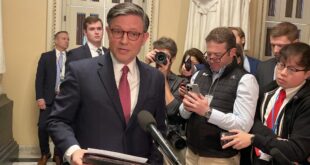Jennifer Shutt, Michigan Advance
The U.S. government could default as soon as next month if Congress and the Biden administration can’t reach a debt limit agreement before then, according to a new analysis from the Bipartisan Policy Center.
The updated guidance, which puts the default window between early June and early August, adds pressure to President Joe Biden and the four congressional leaders for an agreement ahead of a meeting later Tuesday. The not-for-profit center works to help leaders arrive at bipartisan solutions.
“I still don’t think now is the time for panic. But it’s certainly time to start getting concerned because we’re possibly only several weeks away from the x-date,” said Shai Akabas, the center’s director of economic policy, referring to the default date.
“And again, I think we’re really at the early stage of these negotiations between the two parties,” he added.
The Bipartisan Policy Center projections, Akabas said, are consistent with the Treasury Department’s projections, which put the default date as soon as June 1.
“We also see reason for concern in early June, based on the fact that cash flows will be running quite low,” Akabas said.
Potential delays in Social Security payments and more
If the United States were to default for the first time in its history, it would likely mean delays in federal payments for hundreds of programs, including Social Security, Medicare, Medicaid, veterans’ benefits and federal employee salaries.
Depending on how long a default lasted, a global recession could be triggered as well.
Tuesday’s meeting between congressional leaders and Biden will be the first time all five men have sat down together to negotiate on the nation’s borrowing limit, which pays for deficit spending Congress has already approved.
The group doesn’t have much time to work out a deal with both chambers of Congress scheduled to be in Washington, D.C. a total of seven days during May, though leaders can add days to the calendar if needed.
Biden and Speaker Kevin McCarthy met at the White House in February, but have made no progress since then, opting instead to trade barbs in public as the country inches closer to a default that would roil financial markets.
At the center of the dispute is whether changes in federal spending should be tied to legislation addressing the debt limit, or if talks about how much money Congress spends should be kept on a separate track.
Republicans have insisted that future spending cuts move along with any debt limit bill. Biden and Democrats have rejected their calls, saying that negotiations over spending should be independent of the debt limit.
U.S. House Republicans narrowly passed legislation in late April that would raise the nation’s debt limit by $1.5 trillion or suspend it through March 31, whichever comes first. But they included dozens of conservative policies and spending cuts that cannot pass the Democratically controlled U.S. Senate.
That has left congressional leaders and the Biden administration in a stalemate over how to address the country’s debt limit, which has accrued over decades.
GOP Senate letter
A group of 43 Senate Republicans released a letter over the weekend saying they’ll stand with their House GOP colleagues and oppose a stand-alone debt limit bill.
“The Senate Republican conference is united behind the House Republican conference in support of spending cuts and structural budget reform as a starting point for negotiations on the debt ceiling,” Republican senators wrote in the letter.
“Our economy is in free fall due to unsustainable fiscal policies,” Senate Republicans added. “This trajectory must be addressed with fiscal reforms. Moreover, recent Treasury projections have reinforced the urgency of addressing the debt ceiling. The House has taken a responsible first step in coming to the table with their proposals. It is imperative that the president now do the same.”
“As such, we will not be voting for cloture on any bill that raises the debt ceiling without substantive spending and budget reforms,” they wrote.
The letter, however, doesn’t detail specific spending cuts that Senate Republicans want to see, a move that’s likely designed to give Senate Minority Leader Mitch McConnell flexibility in closed-door talks with Democrats.
The letter was signed by Sens. Mike Lee of Utah, John Barrasso of Wyoming, Marsha Blackburn of Tennessee, John Boozman of Arkansas, Mike Braun of Indiana, Ted Budd of North Carolina, Shelley Moore Capito of West Virginia, Bill Cassidy of Louisiana, Katie Britt of Alabama, John Cornyn of Texas, Tom Cotton of Arkansas, Mike Crapo of Idaho, Ted Cruz of Texas, Kevin Cramer of North Dakota, Steve Daines of Montana, Joni Ernst of Iowa, Deb Fischer of Nebraska, Lindsey Graham of South Carolina, Chuck Grassley of Iowa, Bill Hagerty of Tennessee, John Hoeven of North Dakota, Cindy Hyde-Smith of Mississippi, Ron Johnson of Wisconsin, James Lankford of Oklahoma, Cynthia Lummis of Wyoming, Roger Marshall of Kansas, Mitch McConnell of Kentucky, Jerry Moran of Kansas, Markwayne Mullin of Oklahoma, Pete Ricketts of Nebraska, James Risch of Idaho, Marco Rubio of Florida, Mike Rounds of South Dakota, Tim Scott of South Carolina, Rick Scott of Florida, Eric Schmitt of Missouri, Dan Sullivan of Alaska, John Thune of South Dakota, Thom Tillis of North Carolina, Tommy Tuberville of Alabama, J.D. Vance of Ohio, Roger Wicker of Mississippi and Todd Young of Indiana.
No certainty on x-date
The estimate from the Bipartisan Policy Center is similar to the timeline Treasury Secretary Janet Yellen detailed for Congress last week, warning of default as soon as June 1 and urging lawmakers to broker a deal.
“We have learned from past debt limit impasses that waiting until the last minute to suspend or increase the debt limit can cause serious harm to business and consumer confidence, raise short-term borrowing costs for taxpayers, and negatively impact the credit rating of the United States,” Yellen wrote.
“If Congress fails to increase the debt limit, it would cause severe hardship to American families, harm our global leadership position, and raise questions about our ability to defend our national security interests.”
Akabas said during a briefing call with reporters on the Bipartisan Policy Center’s projections that specifying a more narrow window or exact day for when the federal government would default is especially difficult.
“We’re talking about hundreds of billions of dollars of payments that are going in and out,” he said. “And so neither we, nor Treasury, can know with any certainty when the x-date will arrive. Maybe not even a couple days in advance.”
Michigan Advance is part of States Newsroom, a network of news bureaus supported by grants and a coalition of donors as a 501c(3) public charity. Michigan Advance maintains editorial independence. Contact Editor Susan Demas for questions: info@michiganadvance.com. Follow Michigan Advance on Facebook and Twitter.
 Poli Alert Political & Civics
Poli Alert Political & Civics



